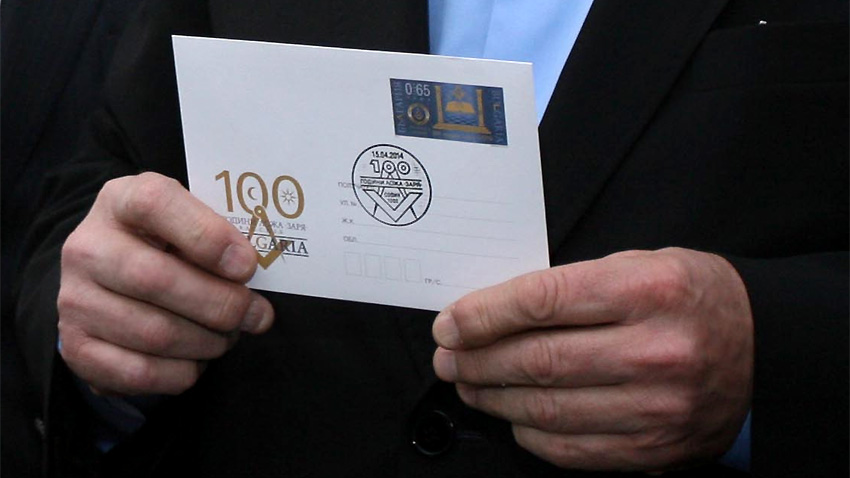An unusual exposition at the exhibition hall of the Archives State Agency has been attracting attention these days. Unique documents, photos and objects, related to the freemasonry movement in Bulgaria are on display there to mark the 100th anniversary of the Zaria lodge, established in Sofia back in 1914. One can touch upon the world of the mysterious elite society that is usually spoken of with awe and guesses. The documents, seizing the history of the lodge up to 1941 reveal that many representatives of the elite back then were part of freemasonry – premiers, ministers, generals, renowned scientists, artists and even priests.
The freemasonry is an enlightenment community of distinguished persons of spirit and intellect. There are about 5 mln freemasons around the world, more than 1 mln of those being US residents; half a million can be found in GB, there are quite many in France either. Unofficial data says that there are some 5,000 masons in this country, in different configurations. The Zaria lodge was established on 15 April 1914 and was registered as the 15th foreign lodge with the Great Lodge of France, with Dr. Hristo Stoichev being the first Protomaster. The organization chart of the Zaria Educational Institute was approved a year later, with the great Academician Alexander Teodorov-Balan as its chair. He adopted the freemasonry ideas along with Gen. Alexander Protogerov, writer Dimo Kiorchev and many other distinguished persons, contributing a lot to its development here. The brotherhood was banned after 1942 in this country and got recovered 50 years later. Today the Zaria lodge has 120 members, the First Master of Chair Rumen Ralchev told RB. The main law of freemasonry reads that anyone, who wants, can represent himself as a mason within the society. Then the ban drops and the other masons can mention or cite him. At the same time the rest are banned from mentioning, as they haven’t declared themselves in public. That is why only older documents are used now, he explains. The almanac with contemporary freemasons is classified. Does freemasonry have its future?
“Of course it does, because this so-called art of kings is millennia old. It always gathers the most progressive part of each society. Its presence there guarantees democracy. I am a real optimist. Moreover, many young people have joined the freemasonry in Bulgaria and this guarantees its future. The brotherhood develops in the same way across the globe. Of course, modern technologies, the Internet, somehow take away a part of the eeriness. At the same time it attracts interest, since its philosophy cannot be taught online. It has to be lived through, in order to be used personally.”
Many of the documents presented at the exhibition come from the personal archive of brother Ivan – photographer Ivan Barnev. What do they tell us?
“The exhibition tells on the establishment of Zaria and its development up to 1941, when the Law on the State Protection banned all secret organizations. The exposition reveals the spirit of that time and comes to show that the elite of our entire nation consisted of freemasons, arguing on the claim that it is a bad secret organization. People can see that actually it is a very serious humanitarian organization.”
A special post edition was issued at the exhibition, subjected 100 years of Zaria freemasonry lodge, including a jubilee post stamp, an illustrated envelope and a special stamp. Artist Viliam Kitanov is the author.

“The freemasonry is overloaded with symbols by default”, Mr. Kitanov explains. “However, this usually means different styles. My job was to select several of those and to work on their style, in order for the results to be combined properly, to hold on each other, including, of course, the mandatory symbols. I do not consider their emblem, but the pillars of the temple are here, the three steps, the compasses, the right angle and other, lesser elements. I tried to implement some graphic jokes, as we, artists, call those – for instance the L letter, written in Cyrillic and Latin, just like the compasses and right angle. The rest is routine expertise.”
English version: Zhivko Stanchev
The only chapel in the country to bear the names of Saints Anthony and Atha nasius is in Sandanski, and its consecration will be performed by His Eminence Metropolitan Seraphim of Nevrokop, reports Andon Kotev - one of the initiators of the idea to..
On January 17, the Orthodox Church honors the memory of St. Anthony the Great – a zealous advocate of Christianity. At an advanced age, he took part in the Church's struggle against the Arian heresy. Anthony got into an open dispute with the..
His Eminence Metropolitan Anthony of Western and Central Europe and BNR Director General Milen Mitev signed a Memorandum of Cooperation at the headquarters of the Bulgarian Orthodox Church Diocese of Western and Central Europe in the German capital,..
Priest Lyubomir Bratoev is a direct participant in the events of t he founding of the Bulgarian Orthodox Church community in Berlin . He came to the..

+359 2 9336 661
